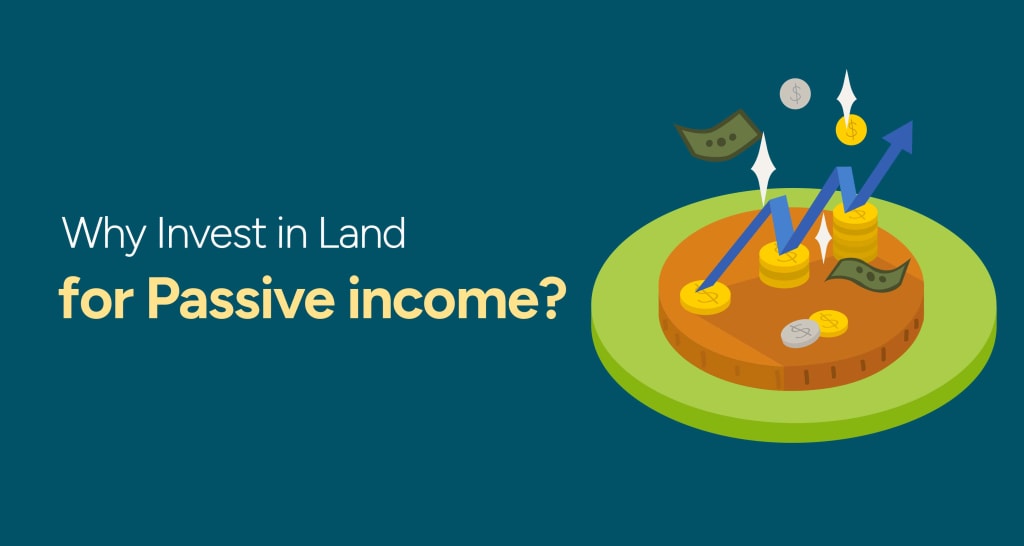Why invest in Land for Passive Income?
Land investment is often viewed as a stable and tangible asset that can generate passive income, offering a unique opportunity to build wealth over time. Unlike stocks or bonds, land is a finite resource, and its value tends to appreciate, especially in areas experiencing growth or development. However, turning land into a source of passive income requires a strategic approach and an understanding of the different ways to monetize your investment. Here's a comprehensive guide to navigating the complexities of land investment for passive income.

Understanding the Basics of Land Investment
Why Invest in Land?
Land investment is appealing because it offers low maintenance compared to other real estate investments like rental properties—no need to worry about building repairs, tenant issues, or other headaches from owning buildings. Additionally, the risk of depreciation is lower; while buildings can deteriorate over time, land does not.
Types of Land to Consider
Residential Land: Ideal for developing housing or subdivision.
Commercial Land: Suitable for businesses, retail complexes, or offices.
Agricultural Land: Used for farming or leasing to farmers.
Recreational Land: For camping grounds, RV parks, or leisure activities.
Strategies for Generating Passive Income from Land
1. Leasing for Agriculture or Grazing
A common way to earn passive income from land is to lease it to farmers or ranchers. This is particularly viable if you own large tracts of rural land. The lease agreements provide a steady income stream while the land continues to appreciate.
2. Timber Sales
If your land has significant timber, you can manage the timber for ongoing income. Sustainable timber harvesting can provide periodic income while maintaining the land's ecological health.
3. Mineral Rights
Owning land with mineral rights can be highly lucrative. If valuable minerals are under your land, companies may pay you for the rights to extract these resources. This can include oil, gas, coal, or even precious metals.
4. Solar or Wind Farms
As renewable energy becomes more crucial, leasing land to solar or wind companies is a growing opportunity. These companies pay landowners for using their land, often with long-term leases guaranteeing steady income for years.
5. Real Estate Development
For those willing to take on more risk and involvement, developing the land into residential or commercial properties can yield significant returns. This could involve selling developed lots, holding onto them, and renting out the developed properties.
6. Recreational Uses
Leasing land for recreational purposes (e.g., hunting, fishing, camping) can attract consistent rental income from individuals or tour companies, especially if the land is in a high-demand area for outdoor activities.
Evaluating and Preparing the Land for Investment
Location and Market Research
The potential for generating passive income dramatically depends on the location. Research demographic trends, future area developments, and economic conditions that could influence the demand for your land.
Legal Considerations
Ensure the land has clear titles, no legal disputes, and appropriate zoning for your intended use. It's often wise to consult a real estate attorney to navigate these aspects.
Infrastructure and Accessibility
Consider the availability of roads, water, and utilities, as these can affect the land's usability and attractiveness to lessees or buyers.
Financial Considerations and Risks
Initial Costs and Ongoing Expenses
While land typically requires less upkeep than developed properties, you may still face costs related to property taxes, legal fees, and essential maintenance.
Market Volatility
Land values can fluctuate due to numerous factors, including changes in local economies, zoning laws, and national economic conditions. While land generally appreciates, there can be periods where the value stagnates or decreases.
Illiquidity
Land is a relatively illiquid asset. Converting your investment into cash quickly can be challenging, especially if market conditions are unfavourable.
Conclusion: Building a Passive Income Stream with Patience and Planning
Investing in land for passive income is not typically a get-rich-quick scheme. It requires patience, diligence, and strategic planning. However, for those who do their homework and understand the market dynamics, it can provide a substantial and steady income source over time.
By diversifying your investment strategies and continuously monitoring market trends, you can turn a simple land purchase into a powerful tool for financial freedom. Whether you lease your land for agricultural purposes, develop it for residential or commercial use, or utilize it for natural resources, each strategy offers a unique pathway to generating passive income while your investment appreciates.
About the Creator
Mypropertymap
MyPropertyMap is a revolutionary land listing platform designed to ease land search. We aim to bring transparency to this industry by offering a digital platform that leverages technology and data for land investments.
Enjoyed the story? Support the Creator.
Subscribe for free to receive all their stories in your feed. You could also pledge your support or give them a one-off tip, letting them know you appreciate their work.






Comments
There are no comments for this story
Be the first to respond and start the conversation.